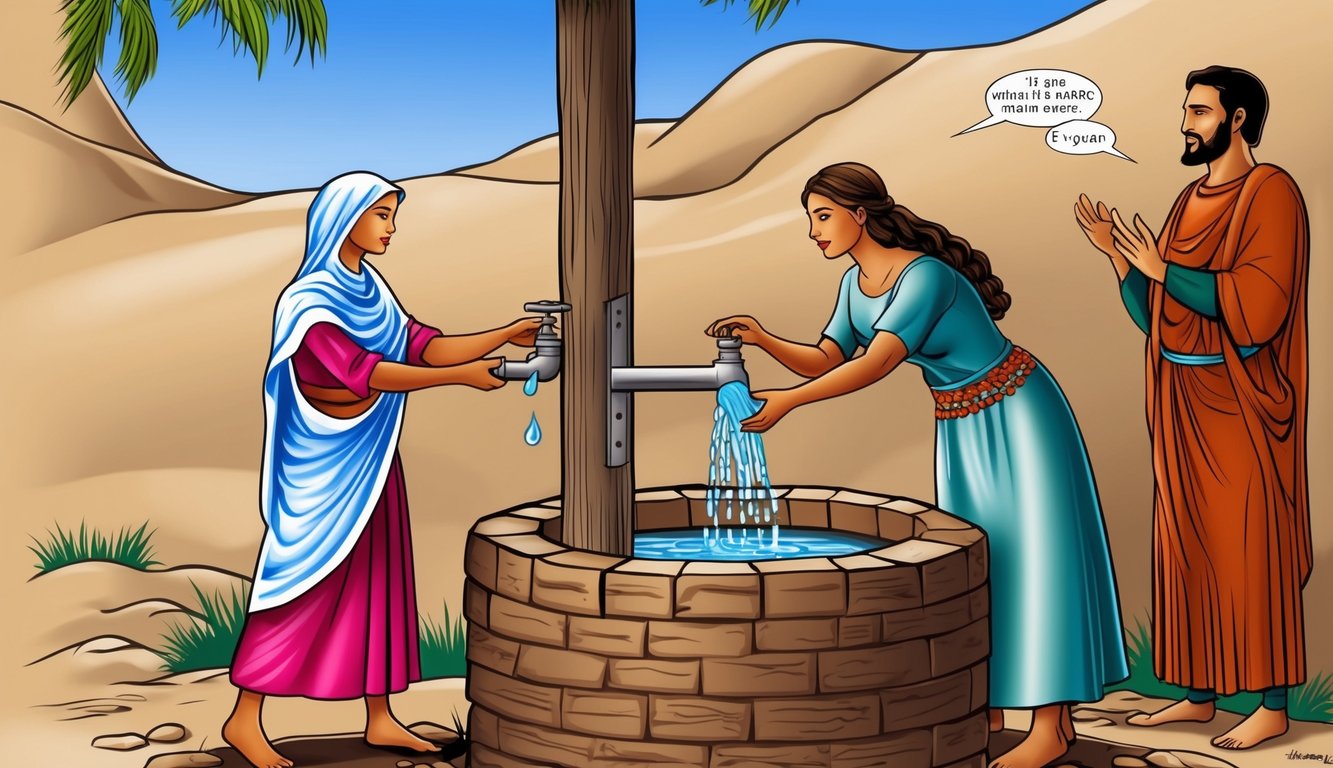Don’t Miss Out On This Unique Astrological Opportunity
Are you tired of spinning your wheels and getting nowhere? Simply put, you’re out of sync: you’re out of alignment with your astral configuration.
But: there’s a kind of map that can help you reclaim your alignment. Think of it as your own personal blueprint to success and happiness: a blueprint that will help you live your most amazing life.
Get started here.
John 4 is a captivating chapter that describes a powerful moment in the Bible where Jesus meets a Samaritan woman at a well.
This passage explores themes of acceptance and redemption, highlighting the breaking of social barriers.
In this encounter, Jesus offers “living water,” symbolizing spiritual fulfillment, which intrigues the Samaritan woman and changes her life.
As you delve into this narrative, you will uncover how Jesus openly reveals his identity as the Messiah, providing profound theological insights into His mission.
The conversation between Jesus and the Samaritan woman offers a deep understanding of worship and the universal call to true worshipers.
This chapter also illustrates how the ripple effect of this meeting impacts an entire community, leading many to believe in Jesus.
The story, found in versions like the New International Version and King James Version, continues to inspire and encourage readers in their faith journey.
Key Takeaways
- Jesus offers “living water” to the Samaritan woman at the well.
- He reveals Himself as the Messiah in this chapter.
- The encounter leads to a broader acceptance and belief in Jesus.
Historical Context and Setting

Understanding John 4 requires you to grasp the journey Jesus took through Samaria, the cultural importance of Jacob’s Well, and the complex socio-religious dynamics between Jews and Samaritans.
These elements provide depth to the encounter between Jesus and the Samaritan woman.
The Journey Through Samaria
Jesus traveled from Judea to Galilee, choosing to pass through Samaria rather than taking the longer route some Jews often used to avoid contact with Samaritans.
This path led Him to Sychar, a town in Samaria.
The decision was significant, highlighting Jesus’s willingness to break social norms.
Jews and Samaritans shared a bitter history, often avoiding each other due to long-standing hostilities.
Being aware of this helps you understand the barriers Jesus crossed, highlighting His mission to reach all people, regardless of societal barriers.
Jacob’s Well and Its Significance
Jacob’s Well is where Jesus met the Samaritan woman.
This well, linked to Jacob, a common ancestor of both Jews and Samaritans, carried historical and spiritual weight.
Located near Mount Gerizim, the well was believed to have been dug by Jacob, featured prominently in stories connecting to Joseph.
Samaritans and Jews held it in high regard, though it belonged to a land with contested religious identities.
Here, Jesus discussed living water, offering spiritual insights that reached beyond physical thirst.
Recognizing the well’s importance enriches your understanding of the narrative’s historical depth.
Socio-Religious Landscape
During Jesus’s time, relations between Jews and Samaritans were tense.
Jews looked down on Samaritans, considering them impure due to their mixed heritage and differing religious practices.
The Samaritans had their temple on Mount Gerizim, which was at odds with the Jerusalem-centric faith practice of the Jews.
This division extended to daily life, affecting where they worshipped and how they interacted socially.
By speaking with a Samaritan woman, Jesus challenged these deep-seated divisions, promoting unity.
This context underscores His radical act of inclusivity, revealing the transformative power of His message that transcends human-made boundaries.
Encounter at The Well
In John 4, Jesus meets a Samaritan woman at a well.
This encounter is significant for its teachings on spiritual truth and identity.
Conversation with the Samaritan Woman
When you read this story, you’ll notice how Jesus begins a conversation with the Samaritan woman by asking for a drink of water.
Though simple, this request breaks several cultural norms, as Jews typically avoided interactions with Samaritans.
Their chat quickly shifts from physical thirst to a spiritual conversation.
Jesus tells the woman about the Gift of God, sparking her interest and curiosity.
She initially focuses on the literal water but soon senses something deeper, especially when Jesus mentions her husbands, revealing His insight into her life.
This prompts her to see Him as a Prophet.
Teaching on Living Water
Jesus introduces the concept of Living Water during the conversation.
He explains this water leads to everlasting life and means far more than the water you drink from a well.
This living water symbolizes salvation and the eternal life found in Him.
It signifies spiritual fulfillment that nothing else can offer.
Jesus promises that those who drink from this spiritual well will never thirst again.
This declaring of spiritual sustenance shows His unique role in delivering eternal satisfaction and salvation, offering hope and transformation.
Revelation of Jesus as the Messiah
The conversation peaks when Jesus reveals Himself as the Messiah.
The Samaritan woman comes to recognize Him as the Christ and spreads this revelation.
When she tells her townspeople about her encounter, they become curious and eagerly approach Jesus.
This encounter not only leads to her belief but also brings many others to faith.
They believed because of the woman’s testimony and Jesus’ words.
Jesus’s bold revelation underscores His mission and breaks barriers, offering redemption and a new understanding to all.
His words challenge traditional boundaries, inviting both the faithful and the seekers into a deeper relationship with God.
In this light, the third commandment meaning today extends beyond merely refraining from misusing God’s name—it calls for a life that honors Him in speech and action.
Through His message, Jesus redefines devotion, urging us to live with integrity and reverence in every aspect of our lives.
Theological Insights and Key Themes

In John 4, important lessons arise from Jesus’ interaction with the Samaritan woman.
Key themes include the nature of true worship, understanding of spirit and truth, and the idea of a spiritual harvest.
These concepts reveal much about Jesus as the Messiah and Savior of the World.
Nature of True Worship
True worship is a central theme in John 4.
Here, Jesus explains to the Samaritan woman that worship is not confined to a location, such as a mountain or temple.
Instead, true worshipers honor the Father in spirit and truth.
This means worship involves a sincere, heartfelt connection with God, beyond rituals or physical places.
Jesus emphasizes that God desires worship that comes from the heart.
For you, this means embracing worship as a personal and meaningful relationship with God rather than just a formal practice. True worship transcends cultural or religious barriers, reminding you of the inclusive nature of Jesus’ message.
Understanding Spirit and Truth
Spirit and truth are vital aspects of worship, as taught in John 4.
Jesus tells the Samaritan woman that God is Spirit, which means you must connect with Him through your spirit.
This requires a genuine and honest approach, without pretenses or pretense.
Truth also plays a crucial role.
Jesus, the Son of God, embodies truth, guiding you toward living with authenticity and integrity.
It involves aligning your life with God’s Word and His teachings.
This approach allows you to experience a deeper connection with the Father, where spiritual truths lead to transformation.
The Concept of Spiritual Harvest
In John 4, Jesus introduces the idea of a spiritual harvest.
When speaking to His disciples, He mentions that the fields are ripe, symbolizing that people are ready to receive His message.
This harvest is about gathering believers into the kingdom of God.
As a follower, you are invited to participate in this harvest mission.
You can share the message of Jesus, the Savior, with others, helping them understand His role as the Messiah and embracing Him as the Savior of the World.
By doing so, you contribute to the spread of faith and spiritual growth among communities, much like the Samaritans who came to believe after their encounter with Jesus.
Impact and Continuation of the Story
In John 4, the effects of Jesus’ encounters ripple through the regions.
The interactions emphasize belief and recognition of Jesus’ importance, spreading beyond just personal encounters.
Samaritans’ Response and Belief
When you read about Jesus’ meeting with the Samaritan woman at the well, it’s clear how significant this moment was.
The woman runs back to her village, eager to share her experience.
This leads to many of the Samaritans believing in Jesus.
Their belief wasn’t based only on the woman’s testimony, but also on their personal experiences with Jesus.
This moment in Samaria marks a change.
It shows how individuals can lead others to faith through sharing personal stories and insights.
The woman’s words moved her community to invite Jesus into their lives, accepting His teachings about eternal life.
It underscores the spreading influence of Jesus’ message in regions like Judea and beyond.
The Second Sign in Galilee
In another impactful event, Jesus heals the royal official’s son in Cana.
This is known as the second sign, illustrating Jesus’ power and compassion.
The official approaches Jesus, desperate for help as his son is fevered and near death.
Through his faith and Jesus’ words, the healing occurs, even at a distance.
The significance isn’t just the miracle but the belief of the official and his entire household.
This sign echoes the earlier miracle of turning water into wine in the same region.
It confirms Jesus’ divine power and introduces a theme of trust before witnessing outcomes.
This story encourages faith and highlights the transformative power of Jesus’ presence and commands.
Frequently Asked Questions

In John 4, key themes include Jesus’ encounter with the Samaritan woman, the concept of living water, and the challenges to traditional social norms.
Understanding these aspects can deepen your insight into the chapter’s messages about faith and worship.
What is the significant lesson from Jesus’ encounter with the Samaritan woman?
Jesus’ meeting with the Samaritan woman shows you the importance of kindness and acceptance beyond social boundaries.
He speaks to her despite the cultural divide and offers her hope and understanding, illustrating the inclusive nature of his message.
How does John 4 portray the theme of spiritual thirst and living water?
Jesus introduces the idea of living water, symbolizing spiritual fulfillment.
He offers this living water to the Samaritan woman, explaining that it can quench spiritual thirst in a way that physical water cannot.
This highlights your need for deeper spiritual nourishment.
In what way does the story in John 4 demonstrate Jesus breaking social norms of the time?
Jesus breaks several societal rules by talking to a Samaritan woman at the well.
During that time, Jews and Samaritans did not usually interact, and men often avoided public conversations with women.
This shows his willingness to challenge norms for greater spiritual truths.
What does John 4 suggest about Jesus’ view on worship and where it should take place?
Jesus emphasizes that true worship is not confined to a specific location.
He tells the Samaritan woman that the time is coming when worship will not be just about a physical place like a temple but about worshiping authentically in spirit and truth.
How is the concept of true worshipers described in John 4?
Jesus describes true worshipers as those who worship in spirit and truth.
This means that your worship should be sincere and from the heart, guided by genuine faith rather than merely following rituals or traditions.
What transformation does the Samaritan woman undergo in John chapter 4?
The Samaritan woman experiences a profound change after speaking with Jesus.
Initially, she is skeptical and curious, but as the conversation progresses, she begins to understand and embrace the message of living water.
She ultimately becomes a believer and spreads the news to others in her community.



